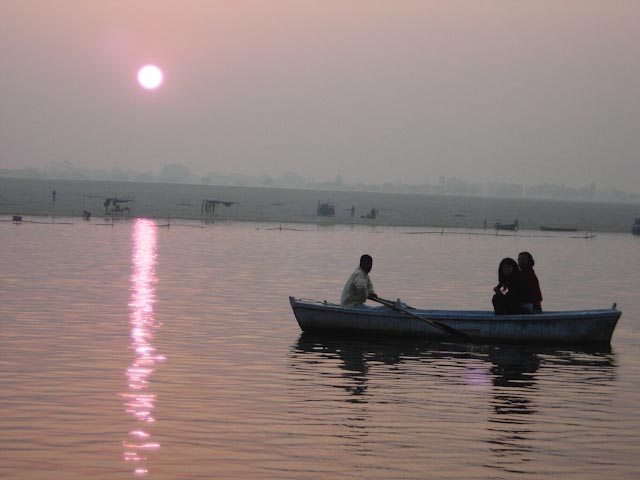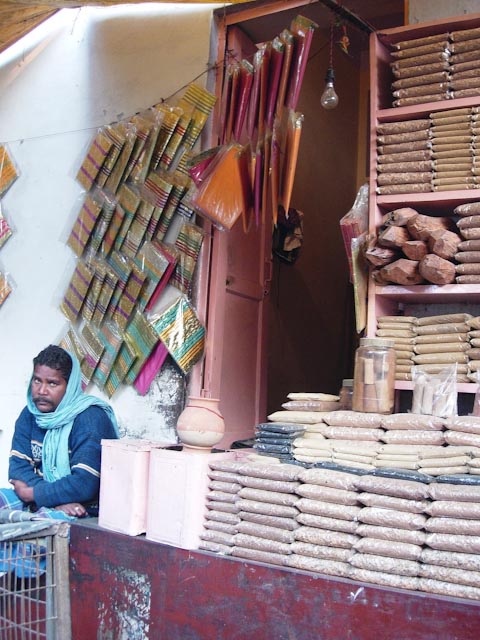Even during the overnight train trip to Varanasi we could discern the rise in temperature. If we needed further evidence, the surrounding farmland was more extensively cultivated and was lush, bordering on tropical.
After we have had time to re-humanise ourselves following the thirteen-hour trip, a local guide takes us on a tour of the nearby town of Sarnath. This place is considered very holy due to its connections to the life of Buddha. It is here that he gave his famous first sermon in the deer park and one of the sites where his ashes were distributed around 600 BC. Buddhist teaching is thought to have provided a platform for the Hindu religion and its influence can be judged by the wheel in the centre of India’s national flag, the Ashoka Chakra, or The Wheel of Dharma. We saw a stone version of this ancient wheel in the Archaeology Museum in Sarnath, as well as the four outward looking lions, which India adopted as its national symbol on 26 January 1950. This sculpture is the capital from one of the pillars erected by Emperor Ashoka 2,200 years ago, the four lions being his emblem. The adoption of this symbol for the whole country was intended to reaffirm his ancient commitment to peace and goodwill.
For many of us, this evening will be the highlight of our tour, but first we must endure an insane tuk tuk driver who insists on constantly turning around to tell us what a great driver he is, as we fang it through the narrow alleyways and passages of Varanasi at a pace to rival that of any James Bond film. Surviving this hair-raising adventure, we were taken down the steps of Kedar Ghat from where we stepped into a small boat on the Ganges at dusk. The air was very still and the only sound was the rippling of the water as our oars broke its surface.
The evening prayer ceremonies at Danaswamedh Ghat had just commenced on our approach. Seven holy men wearing crimson robes with white and gold underclothes were lined up facing the Ganges on a high platform. High above the head of each priest was a rather incongruous neon umbrella that flashed throughout the ceremony (apparently the priests take up residence under umbrellas on the Ghats for consultations and ceremonies for the faithful when they come here to bathe).
During the ceremony the priests were synchronised in their every movement. Bells were being rung throughout while incense plumed out from their offerings. A triangular structure of flames, not unlike a Christmas tree, was dramatically waved around towards the end, followed by peacock fans to put the Ganges ‘to sleep’. The ceremony was finalised with some eerie conch blowing. I heard Sarah remark that the ceremony echoed the high Catholic Church service given the incense, chanting, red robes, candlelight and flame etc. Hmm, an interesting observation, except it is the Catholics mirroring the older Hindu ceremonies I would think (as the Christian religion had a disposition for copying in order to convert), not the other way round.
During this time, members of our group had purchased, for five rupees, banana leaf bowls of orange and magenta petals with a small candle nestled in the centre. These were lit and the bowls released. The deceptively strong current carried them away from us very quickly.
A sense of peace and contentment pervaded the group after this ceremony and we were more mentally equipped for the hairy return ride to the hotel.
The next morning we raced the sparrows again and emerged from the hotel before 6 am. This time we descended the stairs of Danaswamedh, the main ghat and where we had witnessed the previous evening’s pujahs. We picked our way through the chai and flower wallahs, the bead vendors and the sellers of salvation. In no time we were on the bottom step with Mother Ganga lapping near our toes, where pujah detritus of petals and banana leaves had coagulated in front of the boats waiting for their customers.
As we waited for our own boat, an ancient looking gentleman sat cross-legged near our feet wearing only some flesh-coloured underpants as he intoned his morning chants and dabbed himself with oil from a bottle in very specific places, such as the inside of his ankle. He was oblivious to us and we tried to limit our fascinated stares.
Then in the murky dawn light, a cadaverously thin man waded out between the boats (while I tried not to think about cholera and typhoid) and commenced splashing himself in the chest when he was pelvis-deep. He then held his nose and crashed in face forward and rose five times, before more splashing and exiting. This is what I love about the Hindu faith. It caters generously to personal interpretation and all the pujahs we witnessed seemed individual to that person.
We later witnessed some vigorous young men in dhotis with flashing white smiles soaping themselves into a right froth on the steps…hmmm. Moving right along now.
As we rowed up river I noticed our tour leader Shivani discreetly dip her fingers over the side of the boat and place some water on her crown. The droplets remained whole and sparkled on her glossy black hair.

As the sun eventually got out of bed, the far bank of the Ganges came into view. This side is government-owned and has deliberately been left undeveloped. When the annual monsoon raises the tide of the river, the ghats are not completely flooded as the water moves out wide on the other side instead. Even so, one of the ghats had marks registering the levels of recent monsoons and let me tell you, that amount of water is a frightening prospect.
We disembarked down river, having rowed past a ghat where two cremations were in progress and a third ceremony where we could see a family gathered around a shrouded body in preparation for same.
Behind the charred black foreground of this ghat lay towering stacks of wood. Our guide informed us that whenever a (dead) tree is cut down for this purpose, two must be planted in its stead. Sandalwood is the proclivity of the rich, normal wood for those blessed with fewer resources. Such a funeral can cost from 3,000 rupees (approximately $1,000). Not a cheap business for Vingh-Singh-average.
We ascend the ghat steps and wend our way through narrow cobbled alleys and the vendors of death’s accoutrements. Bags of sawdust, sandalwood chips, other wood and charcoal products, incense and flowers. Thankfully these Indian storekeepers were decorous and not aggressive touters of their wares.


The morning’s tour ended with a visit to the Vishwanath Temple, a very sacred temple to Hindus and one which they all wish to visit at least once in their lives. Security is as tight as the duck’s proverbial as there have been fears of revenge over the Ayodhya mosque. That structure was controversially razed by Hindu Nationalists because its builders had supposedly in turn razed a Hindu edifice commemorating some event related to Ram when Adam was a boy. Only Hindus are admitted to this temple but we are allowed to briefly stand at the entrance and look in through the silver doorway. The object of reverence here is a Shivlingam, a phallus shown joined to the female ‘yoni’. Michelle decided this was a must-have souvenir and purchased a small black replica.
‘I’ll keep it on my desk at work,’ she said grinning. ‘It will make me smile because I will be the only one who knows what it represents.’
Ha. Each to their own, I guess.

Comments
Total Comments : ( ) You have to register to post a comment.
RECENT COMMENTS